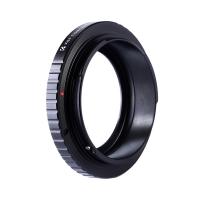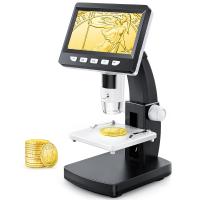Who Invented The Light Microscope ?
The light microscope was invented by Antonie van Leeuwenhoek in the late 16th century.
1、 Hans Lippershey's Contribution to the Invention of the Light Microscope
Hans Lippershey is often credited with the invention of the light microscope. Lippershey was a Dutch spectacle maker who is believed to have created the first working telescope in 1608. While his invention was primarily intended for astronomical observations, it laid the foundation for the development of the light microscope.
Lippershey's telescope consisted of a convex objective lens and a concave eyepiece lens, which allowed for magnification of distant objects. It is believed that Lippershey's design was later modified by other scientists, such as Galileo Galilei, who improved the magnification and clarity of the images produced by the telescope.
The transition from the telescope to the microscope occurred when scientists began experimenting with using the same principles of magnification to observe small objects. It is unclear exactly who first applied these principles to create a microscope, as there were several scientists working on similar inventions around the same time. However, Lippershey's contribution to the invention of the light microscope cannot be overlooked.
Lippershey's telescope design provided the foundation for the development of the compound microscope, which consists of multiple lenses to achieve higher magnification. This innovation allowed scientists to observe and study microscopic organisms and structures for the first time. The light microscope revolutionized the field of biology and paved the way for countless scientific discoveries.
It is important to note that the invention of the light microscope was a collaborative effort, with contributions from various scientists over time. While Lippershey's role in the invention may have been significant, it is difficult to attribute the invention to a single individual. The development of the light microscope was a gradual process, with improvements and refinements made by numerous scientists throughout history.
In conclusion, while Hans Lippershey's contribution to the invention of the light microscope cannot be denied, it is important to recognize that the development of this essential scientific tool was a collective effort. The light microscope has since undergone significant advancements, and our understanding of the microscopic world continues to expand with the use of more sophisticated imaging techniques.

2、 Zacharias Janssen's Role in the Development of the Light Microscope
Zacharias Janssen is often credited with inventing the light microscope, although the exact origins of this invention are still a subject of debate. Janssen, a Dutch spectacle maker, is believed to have developed the first compound microscope around the year 1590. This early microscope consisted of a convex objective lens and a concave eyepiece lens, which allowed for magnification of small objects.
Janssen's role in the development of the light microscope is significant because his invention laid the foundation for the advancement of microscopy. His microscope design was a breakthrough in the field of optics and enabled scientists to observe and study microscopic organisms and structures for the first time. This invention revolutionized the way we understand the world around us and opened up new avenues of scientific exploration.
However, it is important to note that there are alternative theories regarding the invention of the light microscope. Some historians argue that Janssen's invention was actually a collaboration with his father, Hans Janssen, or that it was independently developed by another Dutchman named Cornelis Drebbel. These differing viewpoints highlight the complexity of tracing the exact origins of scientific inventions.
In recent years, there has been a growing recognition of the collaborative nature of scientific discoveries. It is now widely acknowledged that scientific progress often involves the contributions of multiple individuals working in parallel or building upon each other's work. Therefore, while Zacharias Janssen is often attributed with inventing the light microscope, it is important to acknowledge the collective efforts of many scientists who contributed to the development of this essential scientific tool.

3、 Antonie van Leeuwenhoek's Improvements to the Light Microscope
Antonie van Leeuwenhoek's Improvements to the Light Microscope
Antonie van Leeuwenhoek, a Dutch scientist, is often credited with making significant improvements to the light microscope in the 17th century. While he did not invent the light microscope itself, his contributions revolutionized its capabilities and paved the way for modern microscopy.
Before Leeuwenhoek's time, the light microscope was a relatively simple instrument with limited magnification power. Leeuwenhoek, a skilled lens grinder, developed lenses of exceptional quality, allowing for much higher magnification than previously achieved. He also designed a more efficient illumination system, using a small, powerful light source to enhance the clarity of the images.
Leeuwenhoek's most notable achievement was his ability to observe and document microorganisms, which he called "animalcules." Using his improved microscope, he made groundbreaking discoveries about the microscopic world, including the existence of bacteria, protozoa, and sperm cells. His meticulous observations and detailed drawings provided valuable insights into the structure and behavior of these tiny organisms.
While Leeuwenhoek's contributions to microscopy were groundbreaking, it is important to note that he built upon the work of earlier scientists. The light microscope itself was invented in the late 16th century, with credit often given to Hans and Zacharias Janssen, Dutch spectacle makers. However, Leeuwenhoek's improvements and discoveries greatly expanded the capabilities of the light microscope and laid the foundation for future advancements in microscopy.
In recent years, there has been some debate about the extent of Leeuwenhoek's contributions. Some argue that his microscope design was not as revolutionary as previously believed and that his observations were limited to a narrow range of specimens. However, there is no denying that Leeuwenhoek's work significantly advanced the field of microscopy and opened up new avenues of scientific exploration. His discoveries continue to inspire and inform modern microbiology and have cemented his place in the history of science.

4、 Robert Hooke's Discoveries Using the Light Microscope
Robert Hooke is often credited with inventing the light microscope. Born in England in 1635, Hooke was a polymath who made significant contributions to various scientific fields, including physics, biology, and microscopy. In 1665, he published his groundbreaking work, "Micrographia," which detailed his observations using the newly developed light microscope.
Hooke's microscope consisted of a simple design with a single lens that allowed for magnification of up to 30 times. He used this instrument to examine a wide range of specimens, including plants, insects, and even human tissues. Hooke's observations revolutionized the understanding of the microscopic world and laid the foundation for modern biology.
However, it is important to note that Hooke did not actually invent the light microscope. The concept of using lenses to magnify objects had been around for centuries before Hooke's time. The first recorded use of a simple microscope dates back to the 13th century, and more advanced compound microscopes were developed in the 16th century by scientists like Zacharias Janssen and Hans Lippershey.
Nevertheless, Hooke's contributions to microscopy cannot be understated. His meticulous observations and detailed illustrations in "Micrographia" provided the scientific community with a wealth of knowledge about the microscopic world. He was the first to describe and name cells, and his work laid the groundwork for the development of cell theory.
In recent years, there has been a growing recognition of the contributions of other scientists to the development of the light microscope. While Hooke's work was undoubtedly significant, it is now acknowledged that the invention of the light microscope was a collective effort involving multiple scientists over several centuries.
In conclusion, while Robert Hooke's discoveries using the light microscope were groundbreaking and influential, he did not actually invent the microscope itself. The light microscope was the result of centuries of scientific progress, with Hooke's work representing a crucial milestone in its development.








































